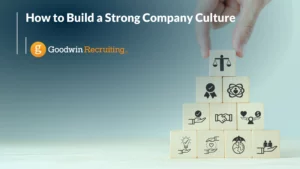How to Build A Strong Company Culture: Insights for Business Leaders
Goodwin Recruiting | Hiring Advice, Leadership, Opinion | January 21, 2024

Knowing how to build a strong company culture is always going to be top of mind if you’re looking to build a successful organization. Do you know what your company culture is currently? How can you tell if it’s good or bad? Have you defined it?
If you don’t define what culture is, you still have one. An undefined culture is a culture because it is the personality of the organization. It’s often a mix of the values attitude, standards, behaviors, and engagement of your team members. So, if you don’t define what those are, they will exist anyway, and they will be modeled after your leadership. In general, people will model the actions they see, and they will likely model the actions of those that are most rewarded.
Let’s take promotions for team leaders as a simple example. People will model the actions they see, and they will model the actions of those that are most rewarded. Whoever you promote will set the stage for all promotions in the future. If you promote toxic behavior at work, everybody will tend to model those actions since it is what they see being rewarded. This is why leaders must work harder than anyone else to uphold the values of the company and they must be more committed to applying and exemplifying the behavior you want in an organization. And with the right values in place, their talent, skill, and knowledge can improve company culture and productivity.
According to company culture statistics gathered from Top companies around the US – 94% of entrepreneurs and 88% of job seekers say that a healthy culture at work is vital for success. And in most organizations, team leaders have the highest impact on company culture, so it is important that you take the time to define what you want that to be.
So in today’s ever-changing workplaces, company culture plays a crucial role in either driving an organization forward or holding it back. But what does it take to build a strong company culture? It requires proactive effort and careful planning. In this blog, we’ll explore some practical tips and fresh ideas for hiring managers and business leaders to take their company culture from good to great.
Understanding the Impact of Company Culture
Company culture, often described as the personality of an organization, is a powerful force that shapes workplace dynamics and influences organizational success. It encompasses values, beliefs, and behaviors that define how things get done within a company. However, If you have 20 division leaders or ten division leaders or even seven division leaders, you’re going to get seven interpretations of what your culture means, so it’s important to take your values and define them with the behaviors and the attitudes you wish to see.
Some specific things to think about when reflecting on your company culture may include asking your organization the following questions:
- Do you make really thoughtful job descriptions to attract a diverse group of qualified candidates?
- How do you think about opportunities for advancement?
- Do you have a clear process or promotion?
- Do employees understand what the criteria are to progress within their career?
- What about the level of collaboration required between team members – Is that something that’s promoted?
- Are examples of collaboration demonstrated and are they celebrated?
- Is there pressure to work when you’re sick?
These are the things that define your culture if you’re not defining them.
A positive company culture has a ripple effect across various aspects of the organization. It boosts employee morale, productivity, and retention rates, while also enhancing the organization’s reputation as an employer of choice. Engaged employees become brand ambassadors, driving customer satisfaction and loyalty. Moreover, a vibrant culture fosters innovation and adaptability by empowering employees to think creatively, take risks, and embrace change. This innovative spirit is crucial for staying competitive in today’s fast-paced business environment.
However, low morale and employee disengagement are significant consequences of a toxic work environment. When employees feel undervalued, unsupported, or unappreciated, it creates a negative atmosphere that can permeate throughout the organization. In such environments, employees may experience a lack of motivation to perform their best or contribute to the organization’s goals. They may feel demoralized and disconnected from their work, leading to decreased productivity and performance.
Stifled innovation and growth are also common outcomes of bad company culture. When employees feel undervalued or fear reprisal for speaking up, they’re less likely to share ideas, take risks, or challenge the status quo. Innovation thrives in environments where employees feel empowered to think creatively, experiment with new approaches, and voice their opinions without fear of judgment or retaliation. However, in toxic cultures, creativity and innovation are often stifled by rigid hierarchies, excessive bureaucracy, or a lack of psychological safety. As a result, organizations miss out on valuable opportunities for growth and adaptation. They become less agile and responsive to changes in the marketplace, which can ultimately lead to stagnation or decline.
In today’s fast-paced business world, staying competitive requires a culture that encourages innovation and embraces change. Companies that fail to foster such environments risk falling behind their more forward-thinking competitors and may struggle to survive in the long run.
What Defines Company Culture
When it comes to company culture, it all starts with looking inwards and setting a good example. First off, take a good look at what’s going on in your workplace – the values, beliefs, behaviors, and norms that are all part of it. Then, get clear on your vision and values by nailing down the core stuff that makes your organization stand out and what you want your team to embody. And hey, don’t forget to get everyone involved in shaping the culture. It’s all about having open chats and bouncing ideas around with people from all over the place.
Think about the important cultural values or themes that really define the kind of environment you want. These will guide everyone and help shape the attitudes and actions we want to see from our team. Set an example by showing through your own behavior and decisions what values are important to us. Make sure to clearly share the company’s values, vision, and cultural expectations with everyone. Whether it’s in meetings, newsletters, on the intranet, or during training sessions, we want everyone to know what we stand for.
Make sure your policies and practices reflect the culture you want by giving them a good look and adjust as needed. It’s important to offer resources and support to help your team grasp and embody the company culture, like workshops, mentorship programs, and leadership training. You can keep tabs on how well your culture-building is working by setting up metrics and key performance indicators (KPIs) to measure and assess your efforts.
It’s okay to adjust and grow your company culture as necessary to stay in sync with changes in the outside world, industry shifts, and feedback from your employees. By taking these steps and regularly promoting your preferred values and behaviors, you can establish a robust and unified company culture that adds to the overall success of your organization.
Defining and molding company culture takes real effort from both leaders and employees. It’s all about building a space where everyone’s on the same page with the company’s values and aims, and where people can grow both personally and professionally.
How to Maintain Company Culture Remotely
The shift to remote work necessitates a reevaluation of traditional approaches to culture-building. Success in remote environments hinges on understanding and addressing employees’ needs and preferences. Soliciting feedback directly from employees provides valuable insights into what drives engagement and satisfaction in remote settings.
To get valuable feedback from your team, it’s crucial to create a culture where open communication is encouraged. Keep in regular touch with your employees through virtual meetings, surveys, or specific feedback channels to ensure their voices are heard. This not only gives them a chance to share their thoughts and ideas, but also helps them feel more included in shaping the company’s remote work culture. And when you’re going through the feedback, really focus on any patterns or recurring themes that come up. You should try to spot areas where things could be better, like improving communication tools or offering more resources for remote teamwork.
Dealing with these issues shows that you’re dedicated to making sure your employees do well and feel good while working remotely. Furthermore, it is crucial to act based on the feedback you get. Be open with your team about what you’ve learned from the feedback and what you’re doing to fix any issues. This builds trust and shows that you value your team’s input and are actively working to make remote work better. Make sure to consistently check in on these efforts to keep improving the remote work experience.
Beyond feedback, it is vital for companies to proactively create opportunities for remote team members to connect and form strong relationships. By organizing virtual team activities, having casual chats, and using online tools to work together, companies can really help everyone feel like they’re part of a team. When businesses focus on this stuff, it helps everyone work together better, take care of each other, and make the work environment awesome. And that leads to everyone being more committed and engaged with their roles.
Ultimately, when remote work experiences reflect the values and priorities of the organization, businesses can help their employees feel proud and purposeful. Open communication, chances for career advancement, and efforts to encourage connection and teamwork are crucial parts of a successful remote work culture.
How to Measure Company Culture
Measuring how well a company’s doing can tell you a lot about its culture. A solid and positive culture usually means the business is performing well. When the team shares the same values and feels like they’re part of something important, they tend to work harder, get more done, and stay focused on reaching the company’s targets.
Employee retention is another important thing to keep an eye on. If a lot of people are leaving the company, it could mean that something’s not right with the company culture. When employees are happy and involved, they’re more likely to stick around for the long haul. But when the vibe at work is negative or toxic, folks might start looking for new gigs because they’re not feeling the love.
Engagement levels are a great way to understand what a company’s all about. According to surveys conducted by Gallup, engaged employees increased productivity by 14% and profitability by 23%. When employees are engaged, they’re really into their work, love what they do, and actively make a difference to the company’s success. They’re the kind of people who go the extra mile, work well with others, and provide quality work. Keeping an eye on engagement levels can help figure out how to make the company culture even better and show what keeps the team motivated and on board.
To really understand how company culture affects business performance, employee retention, and engagement, organizations can use different methods. These might involve regularly asking employees for feedback through surveys and assessments, looking at key performance indicators tied to business results, and keeping an eye on retention rates over time. They could also dig deeper by using qualitative measures, like holding focus groups or conducting interviews, to gain a better understanding of how employees experience and perceive the company culture.
Keeping an eye on company culture effectiveness is super important for making sure everyone has a great working environment that helps the whole team succeed. By checking out things like how the business is doing, how many people are staying with the company, and how engaged everyone feels, companies can figure out what they’re awesome at and what they can do even better. This helps them make smart choices to keep their employees happy and make the whole organization even stronger.
Establishing Clear Company Culture Values and Goals
Having a clear vision, mission, and set of values is super important for building a strong company culture. So, the vision lays out the big goals and dreams of the organization, giving everyone a sense of direction and purpose. The mission statement gets to the core of why the organization exists. It’s like a handbook of what everyone should be doing, making sure that all the different parts of the company are working together. And then there are the values, which are like the heart of the company’s culture. They set the tone for how people should behave and make decisions, shaping how everyone interacts with each other.
These core principles represent what the company believes in, its moral values, and the kind of work atmosphere it wants to establish. Making these values an integral part of the company’s identity can help bring in and keep valuable people who can push its growth forward. Additionally, laying out clear values and goals for the company’s culture is crucial for several reasons.
- Guidance:
- Having clear values and goals gives everyone in the organization a clear direction on how to make decisions and act. It helps employees know what’s important to the company and how to focus on actions that support its mission and vision.
- Alignment:
- A strong company culture makes sure that everyone is on the same page, working toward the same goals and sharing the same values. When everyone’s in sync, it brings people together, encourages teamwork, and makes employees feel like they’re all in it together. This all adds up to getting more done and doing it well.
- Employee Engagement:
- When employees really get behind the values and goals of the company, they tend to be more motivated, engaged, and dedicated to their work. A solid culture can really fire people up to give that extra effort and help the organization succeed.
- Recruitment and Retention:
- Having clear values and goals can really help with finding and keeping great people. When a company’s values align with a potential employee, and there’s an exciting vision for the future, it’s a big draw. Plus, when employees feel like they fit in with the company culture, they’re more likely to stick around.
- Brand Identity:
- Company culture and brand identity go hand in hand. A solid culture sets your organization apart from competitors and contributes to building a great reputation in the marketplace. People, whether they’re customers, clients, or partners, are usually attracted to companies with a strong sense of purpose and values they can connect with.
- Adaptability and Resilience:
- In times of change or uncertainty, having a solid company culture can really help us stay steady and bounce back. When we all share the same values and goals, it gives us a clear direction to handle obstacles and make choices that align with what our organization aims for.
- Ethical Behavior:
- Establishing clear values helps encourage ethical behavior and integrity across the organization. When employees know what’s expected of them in terms of values like honesty, respect, and accountability, they’re more likely to uphold ethical standards when dealing with colleagues, customers, and stakeholders.
By investing time and effort into shaping a clear and compelling vision, mission, and set of values, organizations can build a culture that inspires, motivates, and attracts top candidates from diverse groups.
How to Determine Company Culture
Businesses should give importance to cultural styles that match their goals and values, considering the variety that exists. The Harvard Business Review’s research on this topic identified two main dimensions of culture: how people interact and how they react to change. Using these dimensions, they created a map of 8 distinctive culture styles. Let’s dig into this a bit more.
How people interact
So, when we talk about the first dimension, “people interactions,” it refers to how much individuals in the organization rely on each other. And here’s how this dimension connects to the various cultural types:
- Highly Independent:
- In cultures that really value independence, folks are all about doing their own thing and being self-reliant. They’re big on competition and give props to people who can stand strong on their own. Success is all about what each person achieves and how they perform.
- Highly Interdependent:
- On the flip side, in cultures with a strong sense of interdependence, it’s all about working together as a team to get things done. Success is measured by how well everyone can collaborate and reach common goals. People are appreciated for their contributions to the team and their knack for working well with others.
Knowing where an organization stands on this aspect can give us a good idea of its attitudes towards teamwork, decision-making, and the interplay between individual and group achievements. It can also pinpoint cultural strengths and areas that may need growth or better alignment with the organization’s objectives.
How people respond to change:
The next aspect, “response to change,” is all about how the organization views and deals with change and unpredictability. Now, let’s see how this aspect relates to the different cultural types:
- Stability
- These kinds of cultures are all about keeping things steady. They’re not big fans of change. They’d rather just keep things the way they are and make sure everything stays reliable and predictable. Change makes them feel a bit uneasy, maybe even a little risky, so they’re not really into experimenting with new ideas or ways of doing things.
- Flexibility
- On the other hand, cultures that prioritize flexibility exhibit higher adaptability and are receptive to change. They welcome creativity, trial and error, and ongoing enhancements. Employees are empowered to be nimble and adaptable to evolving market conditions, technological progress, and customer requirements. Instead of a threat, change is perceived as a chance for development and progress.
Recognizing where an organization stands on this dimension can assist leaders in evaluating its preparedness to handle change and uncertainty. It also offers valuable insights into the organization’s potential for innovation, resilience, and capacity to thrive in dynamic environments. By understanding the cultural inclination towards stability or flexibility, leaders can personalize their change management approaches and cultivate a culture that encourages adaptation and growth.
8 Different Types of Company Culture
By grasping these two fundamental concepts, researchers successfully pinpointed and classified eight unique forms of organizational cultures. Each cultural type embodies a special blend of values, beliefs, and behaviors that influence how employees engage with one another and how the organization functions.
- Purpose Culture:
- This culture places a significant emphasis on finding purpose and significance in work. Team members are driven by the organization’s mission and are wholeheartedly dedicated to attaining its objectives. There is an emphasis on creating a beneficial influence and contributing to a greater purpose.
- Caring Culture:
- A caring culture places a high value on empathy, compassion, and support for employees’ well-being. Leaders and colleagues show authentic concern for one another, nurturing a feeling of inclusion and camaraderie. The focus is on nurturing close connections and creating a supportive work environment.
- Order Culture:
- Order culture values structure, organization, and predictability. Clear processes, rules, and procedures are set up to make sure things run smoothly and consistently. Employees understand what is required of them and how to effectively move through the work environment.
- Safety Culture:
- Having a strong safety culture means that employees feel safe speaking up and sharing their thoughts and concerns without worrying about getting in trouble. It’s all about learning from mistakes and being open with each other.
- Authority Culture:
- In a culture of authority, they really value respecting and highlighting hierarchy and authority. Decision-making is centralized, and there’s a clear chain of command. Leaders are seen as decisive and confident, and employees get their roles within the organization and are cool with it.
- Results Culture:
- A results-driven culture is all about hitting tangible goals and performance targets. We’re talking serious accountability, setting ambitious objectives, and coming through with measurable results. People here thrive on tough challenges and get recognized for their successes.
- Enjoyment Culture:
- Enjoyment culture is all about having fun, being creative, and creating a positive work environment. It’s about encouraging employees to have a good time while working, express their creativity, and find happiness in what they do every day. The workplace has a playful and enthusiastic vibe.
- Learning Culture:
- Being part of our learning culture means always striving to grow, develop, and come up with new ideas. We want our team to be curious, take chances, and be open to change. We celebrate learning from both our wins and losses, and we’re all about staying curious and trying new things.
By understanding where their company falls within the spectrum of the eight different company cultures and taking proactive steps to assess and address cultural dynamics, leaders can create a more positive and productive work environment that supports organizational success.
Conclusion
A strong company culture serves as the foundation upon which organizations can thrive and succeed in today’s competitive business landscape. It cultivates an environment where employees feel connected to the company’s mission and values, fostering a sense of belonging and purpose.
When employees are engaged, motivated, and aligned with the organization’s goals, they are more likely to go the extra mile in their work. This leads to improved performance at both individual and team levels, driving overall productivity and efficiency. Employees who feel a strong connection to the company culture are more likely to exhibit innovative thinking, bringing fresh ideas and perspectives to the table. Moreover, a positive company culture prioritizes employee well-being. It recognizes the importance of work-life balance, supports employee growth and development, and encourages a healthy and inclusive work environment. Such a culture fosters employee happiness, satisfaction, and loyalty, which ultimately leads to higher retention rates and reduced turnover.
At Goodwin Recruiting, we understand the importance of actively building a strong company culture for organizations to thrive. By closely collaborating with your hiring managers, our recruiters look to gain a deep understanding of your business, including its values and work environment. This approach makes sure that our candidates have the skills needed and the right values for success. So if you’re looking to discover highly skilled and culturally fit talent, reach out today!
Share This Article














































